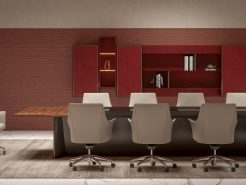What is more important in a business than increasing the motivation, engagement and productivity of employees? There are several ways that companies can improve their employees’ work efforts in the workplace, but one way in particular is often overlooked: that of choosing the right office furniture.
Well, it’s not exactly a way, but rather a facilitator. The right office furniture — desks, chairs, file cabinets and so on — impacts the well-being of employees.
Construction workers, electricians, plumbers or firefighters may not spend too much of their working time around office furniture. But we are currently witnessing the rise of the knowledge-based economy and all those employees spend hours on end at their desks, staring at a computer screen and sitting in a chair.
Engagement and productivity rates drop considerably when physical pain is involved.
Sitting in an uncomfortable chair or typing at too high or too low a desk may not seem such a big deal. But doing this for six, eight or more hours each day, every day, year after year, makes employees be in pain. It’s only a matter of time until they develop bad postures even when not sitting, back problems, wrist problems or neck problems.
And when physical pain gets in the mix with new complex things that need to be learned or thorny work-related issues that need to be solved, employees tend to pay less attention to details, lose focus on what they’re supposed to do and count the minutes until they can get up and go home.
A bad chair or a not-wide-enough desk can hinder the ability of employees to be top performers in a subtle but powerful way. You’ll be surprised of how much employees can stay motivated, engaged and ultimately productive during the day if they sit at their desks correctly and comfortably.
Choosing the right office furniture: Elements of the correct seating
Ergonomic chairs may be the most important piece of office furniture that impacts the physical well-being of employees at work. If they have their backs and wrists supported and they can keep a healthy posture while working, they’ll be less likely to get distracted. It all boils down to not having any pain while working on the computer every day.
With various different types of workplace seating around, it is hard to find the one that perfectly fits all employees’ needs. But, you’ll notice which ones are ergonomically correct once you sit in them. The best ones are the ones that you can easily adjust to various body types and the corresponding comfort needs. The height, the width, and the depth of the chair should be just right. Flexibility is key.
Here are some features that will help you look for the correct seating to help improve the physical well-being of your employees:
Armrests variations
Office chairs should allow for the best comfort in order for the employee’s arms to be at rest at all time when siting. Some chairs don’t have armrests at all and others have fixed ones. Both these types of chairs should be avoided. The lower arms and shoulders of the employee should always feel comfortable while typing.
Swivel mechanisms
The most conventional way for any employee in a knowledge-based job to be able to work comfortably is when his/her chair can easily swivel. This is when the chair can easily rotate in different areas without straining the person’s arms or back.
Height of seats
Office chairs should have a seat height that can easily adjust. This means that they should have the ability to go from 16 to 21 inches “off the floor”. When this happens, the users have their feet flat on the floor, and their arms and thighs evenly proportioned with the height of their desk.
Width and depth of seats
The width and depth of the seat should be comfortable for the person sitting in the chair. The standard width is between 17 and 20 inches. The depth of the seat is often confused with how deep it can go down, but it’s actually how far a person can be seated with their back up against the chair’s backrest. The best chairs should be able to adjust back and forward, allowing two to four inches between the back of the knees and the seat of the chair.
Lumbar support
The ergonomic chair should give enough support to the lower back. This is where the lumbar spine has that inward curve. When people sit for long periods of time, they’ll inevitably slouch. If the lumbar area is not supported, sitting in any chair will become painful in the long run. Ergonomic chairs have lumbar adjustments to perfectly support this specific area of the spine for anyone sitting in them.
Backrest
The backrest of an ergonomic office chair has to be 12 to 19 inches wide so as to support the natural curve of the back. It also should be adjustable when needing to angle it for height and it should have a locking system mechanism in order to prevent it from moving once somebody sits in the chair. This prevents it from going out of place or too far back of an angle.
Material of the seat
The outer material of the seat, whether it’s fabric, leather, or any other type, should have some padding and should be easily cleaned. The cushion of the back should be soft, and so should be the seat. This is especially important for those who sit for longer periods of time.
Keeping these elements in mind when looking for the best office furniture in terms of seating will help you make the right decision. Your employees will be grateful you did. Whether they only need to write an email, participate in an hour-long meeting, attend a three-day training course, or simply think while seated, they’ll be glad they don’t have deal with physical pain while doing their jobs. If they stay healthy, they can keep focus, so the organization’s productivity rates stay high.



.jpg)





